




OS County Series (Cmd 45 1)
"Remains of ROMAN STATION"
placename:- Volantium
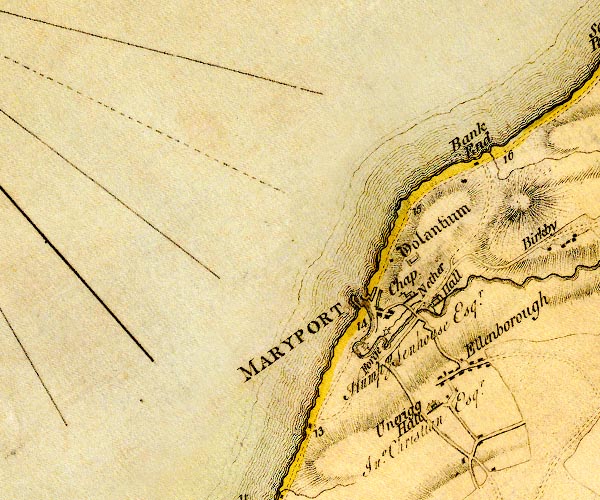
D4NY03NW.jpg
"Volantium"
square within a square; roman fort
item:- Carlisle Library : Map 2
Image © Carlisle Library
placename:- Virosidum
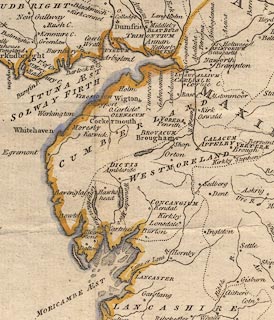 click to enlarge
click to enlargePEN1Cm.jpg
"VIROSIDUM / Maryport"
circle; buildings, village, etc
item:- private collection : 66
Image © see bottom of page
placename:- Volantium
placename:- Virosedum
placename:- Olenacum
item:- roman inscription; insciption, roman; roman altar; altar, roman; roman coin; coin, roman; roman finds
 goto source
goto sourcePage 184:- "..."
"There is perhaps no one station in Britain where so many inscriptions have been found as at Elenborough. The originals are yet preserved at the hall, the seat of Humphry Senhouse, esq; descendant of John Senhouse, esq; whose politeness he possesses in the fullest degree. The first of the altars, described by Mr. Camden, is the finest and most curious ever discovered in Britain. It was found in this station, and removed from Elenborough house to Flat hall the seat of sir James Lowther, near Whitehaven, where it is carefully preserved. Though the altar is fine the inscription is coarse, and, towards the end, nearly effaced, by which I understand that more is effaced than was in Mr. Camden's time. Peregrinus was tribune of a cohort from Mauritania Caesariensis, and repaired the houses and apartments of the decuriones. Wishes for the health of a person equivalent to Volanti vivas are not uncommon. We have in Gruter MCII. 8. Cureti vivas on a Sicilian inscription. Petrei Bibas for vivas on a tessera in Montfaucon. They inscribed their ardent wishes for the health of their friends on the altars, as most effectual to secure the divine protection for them. Mr. Camden takes Volanti for Volantum, the name of this station, which Mr. Horsley makes Virosedum. What Mr. Camden calls a disc is a wheel, the symbol of fortune; his pear is a leaf or pine-apple, as on the fascia of the altar; and what he puts between the two suns at the top Stukeley makes a bust and Horsley a wheat-sheaf."
"The next altar is now in the end wall of a stable at Drumburgh, formerly the seat of the Dacres, now of lord Lonsdale, to which it was removed from Ilkirk by John Aglionby, esq. It is broken through the middle by a tool which has damaged the 5th line. Apronianus and Bradua were consuls A.D. 191, under Commodus."
 goto source
goto sourcePage 185:- "The next inscribed to Belatucader is lost. An optio was a deputy to a Centurion or other officer. We have this deity again in Horsley, Cumb. XXXI. Westm. III. and Archaeol. I. 308. III. 101."
"The 4th inscription is in the hall wall. Horsely takes the figure on the right side to represent Hercules leaning on his club and holding the Hesperian apples, which Gordon makes a patera. Stukeley changes the club into an altar and a patera held in the right hand of a figure much more delicate than Hercules. On the left side is Mars with his spear in his right hand, in his left his shield."
"The next inscription is Horsley's Cumb. LXIV. Gordon's XLIV. Horsley inclines to refer it to Caracalla or Commodus, rather than to Antoninus Pius as Gordon."
"The four next are now lost. The word substituerunt in the seond seems to mean that the monument being erected by Morus Rex in his life-time and decaying was replaced by his heirs."
"The monument of Julia Martina, drawn by Gordon, exhibits her bust rudely cut over the inscription, which is also rude."
"The next with the wreath supported by two Victories, is by Horsley referred to the emperors Dioclesian and Maximian."
"Since Mr. Camden's time the following have been found here. Horsley's LXI. an altar given to Mr. Kirkby of Ashleck, Lancashire, and by his son presented to me."
"Another, LXII. supporting a sun-dial in Elenboro' garden. Another, LXIII. given to the bishop of Man's library in that island, whence the Society of Antiquaries had a copy of it in 1782. Another LXVI was over a door at Elenfoot. Another LXVII. LXIX. an altar to the local goddess Setlocenia or Seticenia in the garden wall. A fragment of an epitaph."
"IL SER
QUI ANAT
CALAPIADO
BVIT CAIA
XIT ANN
MORII VI
DESIDE
RISINT
NONVA."
"LXII. a relief of a female with an urn. Mr. Pennant takes it for the goddess Setlocenia. LXXIII. a relief of a woman in a bath. LXXIV. a relief of an equestrian figure. Here have been since found a fragment of stone with a rude boar and ORD, perhaps part of the name of Gordian; an altar uninscribed, but having on one side an ax and knife: another unfinished found in a quarry with a knife and patera on two sides, probably waiting for a purchaser to inscribe and dedicate it; a relief of a figure in a sagum, holding in one hand a handled vessel like a bucket under a pediment, engraved by Mr. Pennant, pl.III. p.53.56. but the habit or attribute not easy to make out, nor why a Gaul; a large wooden pin with a curious polygonal head, a brazen spout, and some thin gold plates. Near the house in Hall close is an intrenchment 45 yards by 35, perhaps the site of a mansion-house. Mr. Senhouse clearing the station 1766, found the pavements of the streets, foundations of houses, some of them covered with a pink coloured plaister, several vaults, one with freestone steps much used; fire hearths with circular backs with remains both of wood and coal, bones and teeth of animals, stag's horns, many of them sawed, oyster and other shells; fragments of earthen vessels, and a handle inscribed AEL; fragments of glass vessels and mirrors, and two pieces of a painted glass cup. In the vault before-mentioned, supposed to be within the length of the praetorium, 12 feet by 10½, which had been opened before and the pavement taken up, were found a thin piece of beaten gold, a brass ring, stag's horns, a rude relief of three female figures sitting in three niches about a foot high; a piece of stone with a few letters; another with a wheel of six spokes, six inches diameter. This might have been a temple of the Deae Matres, represented in relief. They found among the foundations slates with holes and iron nails in them. The camp is formed on th edge of a high bank overhanging the sea: and about 63 paces south-west from it is a tumulus 250 in circumference, 42 feet slope, and 14 feet perpendicular, called the King's burying place. Mr. Senhouse opened it 1763, but found under different strata of soil (not of stones, as Mr. Gordon), only some bones of an ox. Mr. Horlsey and Mr. Gordon place OLENACVM here on the river Elen; elsewhere the former had placed it at Virosidum. Mr. Camden has little authority for calling it Volantium."
"Horlsey's LXII. LXVI. LXVII. are now in a summer-house."
"A gold coin of Nero was found at Elenborough about two years ago, on the sea shore within flood mark. NERO CAESAR AVGVSTVS Rev. an emperor and empress, AVGVSTVS AVGVSTA."
placename:- Volantium
item:- roman altar; altar, roman; inscription, roman; roman inscription; statue
 goto source
goto sourcePage 171:- "..."
"... at its [Ellen's] mouth Elenborough or the Burgh on the Elen, where was formerly quartered the cohors prima Dalmatarum with their officer. It stood on a high hill commanding a distant view of the Irish sea; but corn now grows where the town was, and its traces plainly appear; the antient vaults are uncovered and many altars, inscriptions, and statues are dug up here. All which that worthy man J. Senhous, in whose grounds they are found, has carefully preserved and arranged in his house. In the middle of the yard is a most beautiful square altar, of a reddish stone, elegantly carved in the antient manner, about five feet high, and having an inscription in fair characters, a view of which and each of its sides I shall here insert from a drawing by sir R. Cotton, of Connington, knt. a great searcher into antiquity, when we travelled together over these parts to illustrate our native country with the highest entertainment in the year 1599. I cannot help expressing my gratitude to the worthy gentleman just mentioned for his hospitable treatment, and the great care which this learned admirer of antient literature takes to preserve these inscriptions, which are soon broken to pieces by the ignorant people here, and put to other uses to the great detriment of these studies. See Pl. VIII. fig. 2, 3."
"Every thing is perfectly plain on this inscription, except that in the last line but one ET and AEDES are expressed in abbreviations. The end is imperfect. Perhaps we are to restore it thus DECVRIONVM ORDINEM RESTITVIT, &c. The Decuriones were in the Municipia the same as the Senatores at Rome and in the colonies; so called because they discharged the offices of the Curia or Court, whence also they were styled Curiales, from their conducting civil affairs."
"On the upper ledge of the back part of this altar we may observe these words VOLANTII VIVAS, which give me no small difficulty, nor can I make anything of them, unless they imply a wish of the Decuriones, knights, and commons, who constitued the Municipium, for G. Cornelius Peregrinus, who restored the house, temple, and Decuriones, that so beneficent a man might enjoy life at Volantium. Hence if I may be allowed to conjecture, I should suppose the antient name of this place to have been VOLANTIVM. Below are carved instruments of sacrifice, a hatchet, and a knife. On the left side a mallet and praefericulum. On the right a patera, a dish, and a pear, if I am right, or as others think a water-pot: for these were vessels for sacrificing purposes, and likewise others, as the Simpulum, Censer, Futile, sacerdotal bonet, &s. which we see on the sides of other altars in these parts. The 2d altar here annexed was dug up at Old Carlisle, and is now in the house of the Barhouses at Ilkirk, inscribed with letters of the complicated form, happily expressed by the engraver, which it should seem are to be read thus:"
"Jovi Optimo Maximo, Ala Augusta ob virtutem appellata cui praest Publius AElius Publii filius Sergia Magnus de Mursa ex Pannonia inferiore praefectus Aproniano (et) Bradua Consulibus."
"The 3d altar is inscribed to the topical deity Belatucadrus, and to be read thus:"
"Belatucadro Julius Civilis Optio (i.e. commander of the watch) votum solvit libens merito."
"There is no difficulty with the 4th altar, which is to this effect:"
"Dis Deabusque Publius Posthumius Acilianus praefectus cohortis primae Delmatarum."
"These kind of altars (to mention the antient rites which our most holy religion has long since abolished), as well as the victims and sacrificers used to be crowned with leaves, and offerings of incense and wine made at them, sacrifices offered, and the altars themselves anointed. Of their demolition as Christianity prevailed, Prudentius thus sings:"
"Exercere manum non poenitet, &lapis illic
Si stetit antiquus quem cingere suerverat error
Fasciolis aut galline pulmone rigare,
Frangitur ---"
"None grudge the helping hand, if chance a stone
Of antient date stood there, whom wont to crown
Was error once with garlands, or to stain
With chicken's blood. They hurl it down amain."
"I also saw the following inscriptions here:"
"PRO SA.........
ANTONINI AV. PII F...
P. AVLVS P. [*]F. PALATINA [sc. tribu]
POSTHUMIVS ACILIANVS
PRAEF. COH. I. DALMATAR."
"[*] D. M.
INGENVI. AN. X
IVL. SIMPLEX PATER
[*] F. C."
 goto source
goto sourcePage 172:- "D.M.
MORI REGIS
FILII HEREDES
EIVS SVBSTITVE
RVNT VIX A. LXX"
"HIC EXSEGERE FATA
... ENVS SC GERMA...
... S REGVIX. AN....
S VIX AN...
... IX..."
"D.M.
LVCA VIX
ANN
IS XX"
"D.M.
IVLIA MARTIM
A, VIX. AN.
XII. IIID. XX H"
"Here also is to be seen this stone, handsomely carved, on which two winged Genii support a wreath as below: See Pl.VIII. fig.7. The inscription is to be read, Victoriae Augustorum Dominorum nostrorum."
placename:- Virosidum
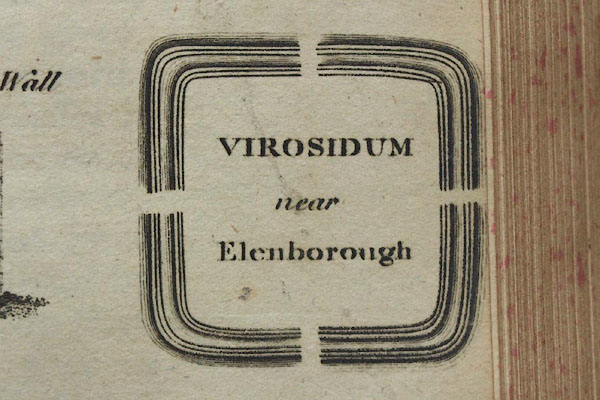
BOX05.jpg
"VIROSIDUM near Elenborough"
placename:- Volannum
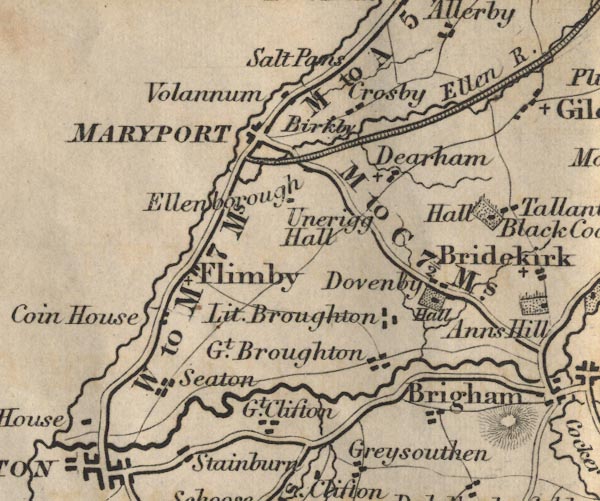
FD02NY03.jpg
"Volannum"
item:- JandMN : 100.1
Image © see bottom of page
placename:- Virosadum
item:- roman altar; inscription, roman; roman inscription
 goto source
goto sourceGentleman's Magazine 1847 part 1 p.594 "..."
"TANNICAE M. COCCEI FIRMUS >(centurio) LEG II AUG."
"A celebrated altar, found at Virosadum, now Elenborough, and which was esteemed by Horsley as "the finest and most curious Roman altar that ever was discovered in Britain," was erected by Gaius Cornelius Peregrinus, "GENIO LOCI, FORTUNAE REDUCI, ROMAE AETERNAE ET PATO BONO." (Hodgson, p.241.)"
placename:- Alauna
placename:- Virosidum
placename:- Ellenborough
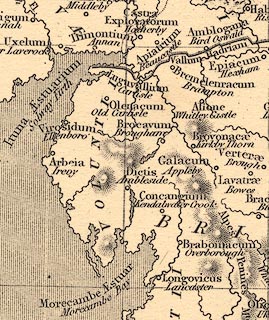 click to enlarge
click to enlargeHOR1Cm.jpg
"Virosidum / Ellenboro'"
item:- JandMN : 429
Image © see bottom of page
: 1936: Trans CWAAS: series 2 vol.36: pp.85-99
: 1958: Trans CWAAS: series 2 vol.58: pp.63-67
: 1965: Trans CWAAS: series 2 vol.65: pp.115-132
